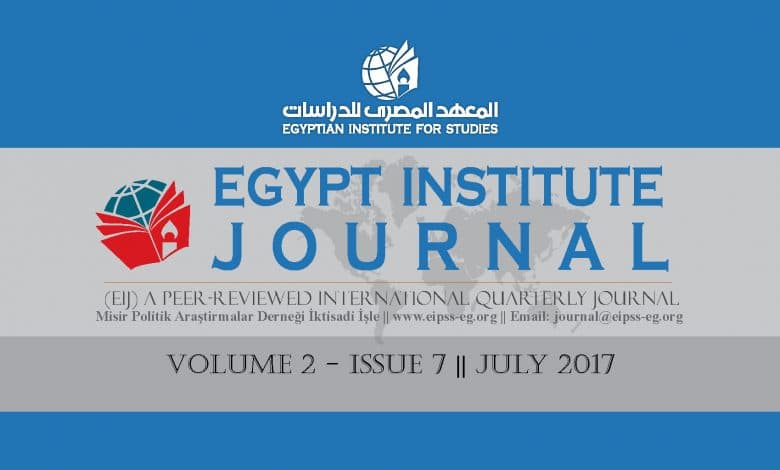
Egypt Institute Journal (Vol. 2 – Issue 7)
Introduction of Egypt Institute Journal (Vol. 2 – Issue 7)
Issue No.7 of the Egypt Institute Journal, published in July 2016, included a number of political, strategic, economic, intellectual and legal articles, as follows:
1- ‘A Hundred Days after Trump Came to Power: Paths and Scenarios’, by Dr. Amr Darrag
The study seeks to evaluate Trump’s performance during the first hundred days of his rule, and to examine whether Trump will succeed in reversing the equation in his favor by imposing his agenda and overcoming the political establishment, or the establishment will succeed in including and directing him, as it has greatly succeeded during the first one hundred days (which is the main question raised since the beginning of Trump’s term).
2- ‘The Institutional Structure of the Muslim Brotherhood: An Analytical Approach’, by Yomna Soliman
The study proceeds from the fact that the Muslim Brotherhood is one of the earliest organizations in Egyptian modern society and that over time the group’s strengths remarkably increased, up to reaching power before the military turned against it and overthrew its government in July 2013. In this context, the study seeks to explore the sources of institutional strengths of the Muslim Brotherhood and assess it according to Samuel Huntington’s model on institutionalization.
3- ‘Transformations of Jihadist Political Discourse’, by Abdel-Ghani Mazuz
This study deals with the transformations in the jihadist political discourse, and the factors and determinants that pushed these transformations to emerge in the way they have appeared. Based on the analytical approach and content analysis, the study attempts to track and monitor the transformations in the jihadist political discourse through exploration within in the jihadist literature about developed concepts and ideas that are new to the jihadist lexicon.
4- ‘Egyptian Jihadist Movements: Limits of the Role’, by Ahmed Mawlana
This study addresses the Egyptian ‘Jihad Group’ through tracking the organizational development of the Egyptian jihadist stream starting from scattered jihadist groups to the ‘Jihad Group’ during the period from 1966 to 1988. The study, then, discusses in detail the Jihad Group, addressing its goals, its strategy for change, its organizational structure, its sources of financing, the field developments it has undergone, its most prominent operations, the internal problems it faced, and its relations with regional states and other groups, leading to the stumbling of its transformative project and the backgrounds of its integration with al-Qaeda as well as the reviews conducted in prisons and their effects. The study, which relied in the historical narration of events on books of the Jihad Group’s leaders and cadres, concludes with providing a general assessment of the group.
5- ‘The End of the Cold War and Theorization in International Conflict’, by Dr. Belkheirat Houssain
The study suggests that the effect of the end of the Cold War on the development of the conflict phenomenon does not only include the practical aspects of forming that phenomenon in the reality of international relations, but it also includes the cognitive aspects of studying this phenomenon.
6- ‘The Kurds and the Consensual System in Iraq’, by Dr. Jassem Al-Shammari
The study provides a historical overview of the Kurds, their origins and their most prominent leaders, and their relations with the Iraqi governments since the 1920s until now. Then, it addresses the issue of the Kurdish state in terms of the potentials available to achieve this dream, and the current and future obstacles they face, as well as the local, regional and international situation on establishment of this state. The study also discusses the origin of the problem between Baghdad and Erbil, whether they have a permanent or interim partnership, and the most important forms of partnership, as well as the most prominent problems between the two parties, and the future of this relationship.
7- ‘How to Create a Symbol: The Case of Bassem Youssef’, by Osama Al-Rashidi
The study explains how the phenomenon of the Egyptian TV presenter ‘Basem Youssef’ has shifted from a challenge to the status quo from outside the prevailing media and cultural system to full integration with the system. It shows how Egypt’s pro-regime cultural system managed to exploit this phenomenon to achieve its goals, and then got rid of it in the end. The study tracks the phenomenon of Bassem Youssef since he appeared in videos clips on YouTube in 2011 until the suspension of his program on ‘MBC Egypt’ in 2014, and his relationship with the prevailing media system which he was critical of at the beginning but later became part of it.
Egypt Institute Journal (Vol. 2 – Issue 7) link
To Read Text in PDF Format Click here.



